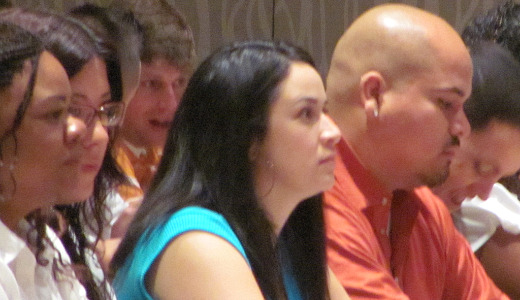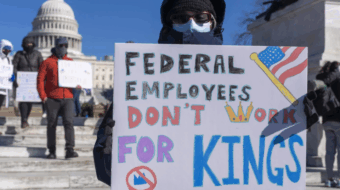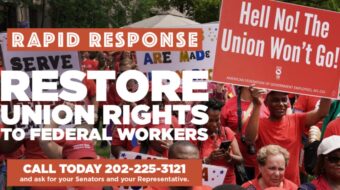
WASHINGTON – AFL-CIO President Richard Trumka reminded state and local labor leaders meeting here this week that even the nation’s largest labor federation, an organization that changed the course of U.S. history in the 2008 elections, is powerless without boots on the ground. More than money or anything else, he said, “union power is people power, it is about boots on the ground. Your union members are the power.”
If this week’s meetings are any indication, the labor movement is approaching what many here feel is its most important moment in 75 years – the 2010 elections – with a firm understanding of how to build that “people power.”
Some leaders here think the U.S. labor movement really began to understand union power in this way in 2006. That was year the nation’s unions moved to put the brakes on the Bush agenda. They organized a campaign that ended Republican control of both the House and the Senate.
Labor improved upon that effort in 2008, and the result was President Obama moving into the White House with big Democratic majorities in the House and Senate.
Labor leaders attribute that success to an AFL-CIO political program that did not exist before 2006. The federation endorsed candidates before that, but there was nothing in place like the election program that exists now, they say.
In the past the labor movement would put money into elections and sometimes send staff out in a top-down effort that didn’t always pay off with results.
Today, the approach from the federation’s headquarters here is to use money, resources, equipment and talent to aid local unions in building efforts that local trade unionists plan, carry out and control. The AFL-CIO can endorse a candidate or back a march in Washington but the plans work to the extent that a determined, energized union membership on the local level is making them work. And they work even better if the local unions reach out to local allies who also have a stake in making them work.
The challenges union leaders face in carrying out an election program are enormous. In addition to dealing with the organizational challenges of pulling off a national political effort they have had to deal with a lot of discussion this summer about an “enthusiasm gap” between people who voted for change in 2008 and the right-wingers chomping at the bit over what they hope will be their chance to come back into power.
“You’ve heard that talk,” Trumka told the labor leaders this week. “I’ve heard it too. But what has happened? Do you think for one moment that the people who wanted change and were so charged up two years ago suddenly changed their minds and want to go back to the way things were before?”
He answered his own question with a “no.” The so-called enthusiasm gap is the result of a right-wing strategy designed to keep voters home out of frustration, he said.
The Republicans figure if they can thoroughly disgust progressives, then the right-wing radicals, the corporate conservatives and the tea party fanatics can win the election, Trumka said.
The “enthusiasm gap” among progressive voters, he told the union leaders, is also the result of frustration that comes from watching Republicans throw up roadblocks on every single thing workers care about, and additional frustration comes from watching some of the Democrats “we thought were our friends” join them saying, ‘Go slow, play it safe, split the difference.'”
Understanding that these factors, not a shift to the right, are behind polls that show progressives losing enthusiasm enables the federation to develop a political program that responds properly to the issues. But then, trade unionists have to actually take that AFL-CIO election program and convert it into a boots-on-the-ground operation.
Local unions are at the heart of this effort, this week’s meetings emphasized.
Leaders here said a key task is to build trust and credibility in the eyes of local union leaderships. To this end they have been developing relationships with the local unions, starting with a contact from a central labor council or state federation leader the local leader already knows. After a relationship is established, the AFL-CIO staff can roll out the program, ask for support and, if they get that support, offer all kinds of assistance. The assistance can be in the form of educational presentations, phone lists, mailing labels, purchasing phones for phone banks, fliers, training sessions or help in setting up press conferences. Local efforts are then publicized in state and national union publications, giving the locals moral support and encouragement all the way up the line.
Union leaders and staffers were also reminded here this week that they are guests in the locals, which are the homes of the union members. They were reminded that local union leaders have demanding jobs that include servicing contracts, handling grievances, and tending to the needs of their members. They were reminded that, because local leaders are so busy, the AFL-CIO’s political program can end up as second priority and they should understand and accept that.
Even in many situations where the political program takes second priority, leaders here said that locals were able to produce winning majorities in both 2006 and 2008.
No one can predict for sure what will happen on Election Day. Based on its recent history and on the level of planning now evident in the labor movement, however, no one should place any bets on a Republican takeover of the Congress this year. Leaders here are confident that if the local unions do this year what they did in 2006 and 2008 the country will move forward, rather than backward.
Photo: Some of the next generation of union activists who participated in the AFL-CIO’s packed “Next Up: Young Workers Summit” in June. (AFL-CIO/Julie Hunter)










